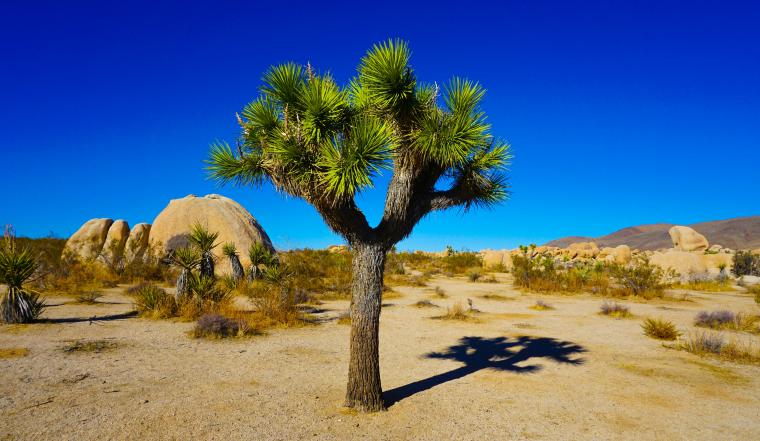
In a nutshell
Understanding how climate change is affecting species is especially important for threatened or endangered species, which already exhibit perilously low species numbers.
Joshua tree (Yucca brevifolia) is an archetypic plant of the Mojave Desert of southern California, parts of Arizona, Utah, and Nevada, and northwestern Mexico. Not technically a “tree,” because these plants are more closely related to palms than they are to the trees of the eastern forests, they are the most tree-like plant in an ecosystem characterized by mostly low-lying catci, shrubs, grasses, and herbaceous plants. The trees are easily recognizable the world-round, bearing a strong resemblance to the Truffula trees of Dr. Seuss’s book, The Lorax. Unfortunately, it’s also considered “threatened” under the California Endangered Species Act, meaning that the plant’s population numbers are dipping precariously low. Joshua trees are vulnerable to wildfire and are losing habitat due to development in California. As well, warmer, drier conditions challenge baby Joshua tree survival.
A research team led by Jeremy Yoder at California State University, Northridge sought to determine the environmental conditions that Joshua trees must experience to trigger flowering. Using over 10,000 images of Joshua tree contributed to iNaturalist, the team developed a machine learning model to predict flowering timing. They then predicted whether and when Joshua trees flowered in years past, back to 1900, and tested the performance of the model in predicting the timing of flowering by comparing the predictions to observations contributed to Nature’s Notebook. They determined that over the past 120+ years, the trees have increased how frequently they flower, as a result of progressively warmer temperatures and more variable rainfall over the period.
While the more frequent flowering is a good sign for the plant’s survival, producing more seeds and ultimately more baby Joshua trees, the plant may still struggle to persist. Warmer temperatures can lead to greater drought stress, and if young seedlings do not receive sufficient or consistent rainfall, they will not survive. The more variable precipitation occurring in recent years works against the survival of tender young plants.
What is special about this study?
Joshua tree is a keystone plant of the Mojave Desert, meaning that it provides crucial food and shelter for many species in the ecosystem. If it were to go extinct, the ecosystem would change drastically. As such, understanding the species’ vulnerabilities and how it is faring in an era of rapid change is important.
Because of the size and shape of the plant’s leaves and flowers, few historical records of this plant exist in herbaria or other records. This lack of historical records challenges efforts to assess how the timing of flowering has changed in recent years. However, the plant is highly recognizable and very representative of the Mojave Desert, meaning that it is an ideal subject for iNaturalist observers. The authors capitalize on this fact to undertake a historical reconstruction of when the plant flowered over more than a century in a creative way.
What does this mean for YOU?
The authors of this study stressed that without volunteer-contributed data such as observations contributed to iNaturalist and Nature’s Notebook, this study – and the important findings – would not be possible. The observations of Joshua tree contributed by participants in these programs were crucial in findings that are being used by the U.S. Fish and Wildlife Service in assessing the species’ status and management.
Citation: Yoder, J.B., A.K. Andrade, L.A. DeFalco, T.C. Esque, C.J. Carlson, D.F. Shryock, R. Yeager, and C.I. Smith. 2024. Reconstructing 120 years of climate change impacts on Joshua tree flowering. Ecology Letters 27:e14478. https://doi.org/10.1111/ele.14478